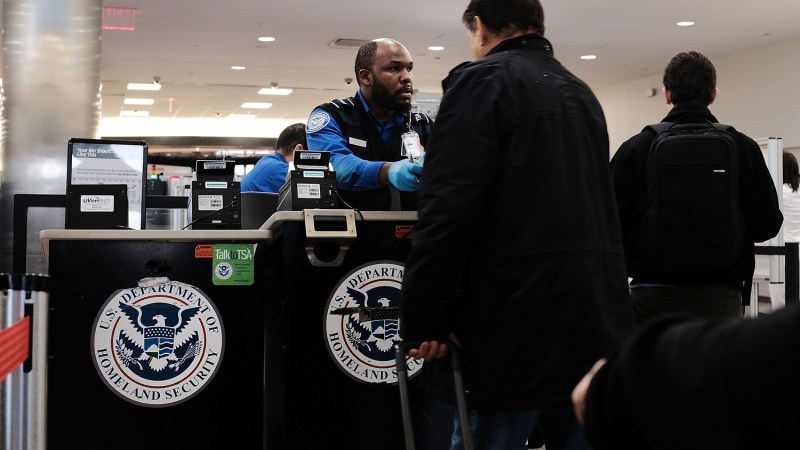Special programs to get through airport security are fantastic, especially during the busy holiday season. Breezing through those long security lines removes a lot of stress from a day full of flying. Unfortunately, some airports–especially when you’re traveling internationally–don’t have these options. PreCheck and Clear aside, it’s still possible to simplify your journey through airport security if you’re willing to switch up how you plan and prepare for the airport.
When you really look at the cause of those dreaded TSA lines, the culprit is usually a lack of open lanes, passenger error, or both. Everyone has seen folks forgetting they have things in their pocket, getting pulled to the side for a bag inspection, or worse, marching off to some scary TSA room for a pat down. While we can’t ensure every airport has enough lanes open, we can show you how to get through TSA faster so your travel plans aren’t derailed or delayed. More time to browse duty-free is always nice, right?
Dress the part

Hats off, sweaters off, belts off, shoes off–the list goes on. Yes, airport security practically wants you to get undressed to proceed to your gate, which can be frustrating. The solution is a simple one that seems to go over most people’s heads: wear airport-friendly clothing. Below are some tips for planning a hassle-free outfit to wear to the airport.
- If you’re in a climate that requires a coat or jacket, put it in your carry-on luggage or take it off while standing in line, not when the security agent reminds everyone for the third time. This includes hoodies, zip-ups, athletic jackets, overshirts with buttons, etc., especially if they have pockets.
- Pick a pair of bottoms without pockets. This trick has saved me countless times at the airport–I don’t have to worry about emptying my pockets if I don’t have pockets. It’s incredible how X-ray scanners can pick up on lint or loose coins in your pockets and cause you to get patted down or retry the X-ray, so it’s better to go pocketless for the day.
- Wear pants that don’t require a belt. Airport security in most countries will require you to remove it, and removing a belt isn’t always as speedy as you may think.
- Hats off. With the exception of religious head coverings, hats must be removed when going through security. Avoid a slowdown by putting it in your carry-on or not wearing one that day.
- Stow your watch and any other heavy or large jewelry items in your carry-on and put them on after security if you’d like. These can trigger the metal detector and slow you down. Smaller jewelry items or piercings can stay on.
- Some countries require shoe removal when going through security. Opt for slip-on shoes when possible. If a laced pair is a must, keep them laced loosely so they can slip off easily.
Pack accordingly

Whether you like to travel light or bring your whole closet, chances are you’ll have some sort of carry-on with you. Airport security has somewhat stringent regulations on what can be brought in a carry-on and what cannot.
Below are some other items that are not allowed in your carry-on:
- Sharp items (tweezers, pliers, pocket knives, etc.)
- Aerosol items
- Ammunition
- Excess lighters or matches (TSA will usually allow one lighter or box of matches)
- Sporting gear/equipment
- Self-defense items (pepper spray, tasers, etc.)
Trying to bring prohibited items on the plane will result in your bag being pulled for inspection by security and, worse, whatever the prohibited item will be tossed out. This will not only slow down how quickly you can get through security but also slow down the process for other travelers since there are only so many agents available.
When flying in the U.S., it’s imperative to remember to adhere to the 3-1-1 rules for liquids in carry-on bags. This means liquids and creams must be 3.4oz or smaller in size and fit in a one-quart bag, limited to one per passenger.
Keep documents handy

When you initially approach the TSA agent at the airport, you are required to present a boarding pass and some form of ID. When traveling internationally, your passport and even a copy of your visa may need to be shown before you’re allowed through security. Countries like Colombia require a special immigration form to be filled out online before you’re allowed to go through security. Additional documents may be needed when traveling with animals, special medications, or equipment.
Keep these items on hand and easily accessible so you’re not fumbling to find them when you need to present them when you get to the counter.
Do your research

The specifics of what is or is not allowed are standard in the U.S. but will vary from country to country. A quick internet search can be the perfect preventative method to avoid an airport incident that leads to a missed flight for you and delays for everyone else in your security line. These tips may seem small, but too many pockets, the wrong shoes, and an improperly packed bag can easily add 15 minutes to your airport security process and be the difference between a smooth time at the airport and a missed flight.




